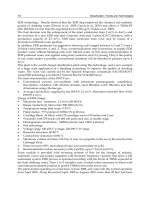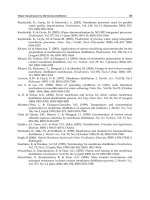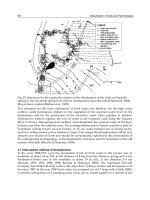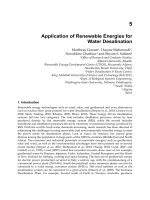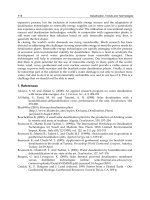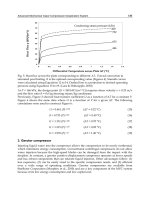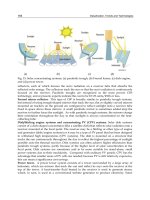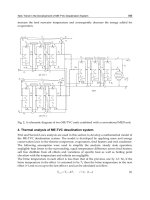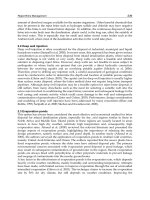DESALINATION, TRENDS AND TECHNOLOGIES Phần 7 pdf
Bạn đang xem bản rút gọn của tài liệu. Xem và tải ngay bản đầy đủ của tài liệu tại đây (1.48 MB, 35 trang )
New Trend in the Development of ME-TVC Desalination System
199
Motive steam, kg/s
7 8 9 10 11 12 13 14 15 16 17 18
D
i
kg/s
10
15
20
25
30
35
D
1
D
2
D
3
D
4
D
5
D
6
D
7
D
8
98.0
63
3
1
=
=
=Δ
r
s
o
o
D
D
CT
CT
Fig. 5. The effect of motive steam on the distillate production from the effects.
Top brine temperature,
o
C
60 62 64 66 68 70 72
Gain output ratio, GOR
8.5
9.0
9.5
10.0
10.5
11.0
11.5
Distillate production, MIGD
5.2
5.4
5.6
5.8
6.0
6.2
6.4
6.6
6.8
7.0
GOR
MIGD
Fig. 6. The effect of top brine temperature on the distillate production and gain output ratio.
because more amount of sensible heating is required to increase the feed seawater
temperature to higher boiling temperatures. Additionally, the latent heat of the vapor
decreases at higher temperatures.
The direct dependence of the top brine temperature on the specific heat consumption and
the specific exergy consumption are shown in Fig. 7. Both of them increase linearly as the
top brine temperature increases, because higher top brine temperature leads to higher vapor
pressure and consequently larger amount of motive steam is needed to compress the vapor
at higher pressures. Fig.8. demonstrates the variations of the specific heat transfer area as a
function of temperature difference per effect at different top brine temperatures. The
increase in the specific heat transfer area is more pronounced at lower temperature
difference per effect than at lower top brine temperatures. So, a high overall heat transfer
coefficient is needed to give a small temperature difference at reasonable heat transfer area.
Desalination, Trends and Technologies
200
Top brine temperature,
o
C
60 62 64 66 68 70 72
Specific heat consumption, Q
d
kJ/kg
200
220
240
260
280
Specific exergy consumption, A
d
kJ/kg
50
55
60
65
70
Q
d
A
d
Fig. 7. The effect of top brine temperature on the specific heat consumption and specific
exergy consumption.
Temperature drop per effect,
o
C
2.0 2.2 2.4 2.6 2.8 3.0
Specific heat transfer area, m
2
/kg/s
400
500
600
700
800
900
T
1
= 65
o
C
T
1
= 63
o
C
T
1
= 61
o
C
Fig. 8. The effect of temperature drop per effect on the specific heat transfer area.
The exergy analysis is also used to identify the impact of the top brine temperature on the
specific exergy destruction for different ME-TVC units as shown in Fig.9. It shows that as
the top brine temperature increases, the specific exergy destruction of ALBA, Umm Al-Nar
and Al-Jubail plants are increased. It shows also that Al-jubail unit has the lowest values
compared to other units. Fig.10 gives detail values of exergy destruction in different
components of Al-Jubail units, while Fig.11 pinpoints that thermo-compressor and the
effects are the main sources of exergy destruction. On the other hand, the first effect of this
unit was found to be responsible for about 31% of the total effects exergy destruction
compared to 46% in ALBA and 36% in Umm Al-Nar as shown in Fig.12.
New Trend in the Development of ME-TVC Desalination System
201
Top brine temperature,
o
C
60 62 64 66 68 70 72
Specific exergy destruction, kJ/kg
20
40
60
80
100
120
ALBA, 4 effects
Umm Al-Nar, 6 effects
Al-Jubail, 8 effects
Fig. 9. The effect of top brine temperature on the specific exergy destruction for different units.
Top brine temperature,
o
C
60 62 64 66 68 70 72
Specific exergy destruction, kJ/kg
0
5
10
15
20
25
30
35
Effects
Thermo-compressor
Condenser
Leaving streams
Fig. 10. The effect of top brine temperature on the specific exergy destruction in different
components of Al-Jubail ME-TVC unit.
Fig. 11. The exergy destruction in the effects, thermo-compressor, condenser and leaving
streams of Al-Jubail unit.
Desalination, Trends and Technologies
202
Fig. 12. The exergy destruction in the effects of ALBA, Umm Al-Nar and Al-Jubail units.
6. Development of ME-TVC desalination system.
The first ME-TVC desalination unit of 1 MIGD capacity was commissioned in 1991 in the
UAE. It has four effects with a gain output ratio close to 8. A boiler was used to supply
steam at high motive pressure of 25 bars (Michels, 1993). The next unit capacity was 2 MIGD
which started up in 1995 in Sicily (Italy). It consisted of four identical units; each had 12
effects, with a gain output ratio of 16. The steam was supplied from two boilers at 45 bars to
the plant (Temstet, 1996). More units of 1, 1.5 and 2 MIGD were also ordered and
commissioned in UAE between 1996 –1999 due to excellent performance of the previous
projects (Sommariva, 2001).
New Trend in the Development of ME-TVC Desalination System
203
The trend of combining ME-TVC desalination system with multi-effect distillation (MED)
allowed the unit capacity to increase into a considerable size with less number of effects and
at low top brine temperature.
The first desalination project of this type was commissioned in 1999 by SIDEM Company in
Aluminum of Bahrain (ALBA). A heat recovery boiler is used to supply high motive steam
of 21 bars into four identical units of 2.4 MIGD. Each unit had four effects with a gain output
ratio close to 8 (Darwish & Alsairafi, 2004). The next range in size was achieved is 3.5 MIGD
in 2000. Two units of this size were installed in Umm Nar; each unit had six effects with a
gain output ratio close to 8. The steam was extracted from a steam turbine at 2.8 bars to
supply two thermo-compressors in each unit (Al-Habshi, 2002). This project is followed by
Al-Taweelah A
1
plant, which was commissioned in 2002 as the largest ME-TVC project in
the world at that time. It consists of 14 units; each of 3.8 MIGD. The next unit size that
commissioned was in Layyah with a nominal capacity of 5 MIGD (Michels, 2001). The unit
size jump to 8 MIGD in 2005 where two units were built in UAE. SIDEM has been also
selected to build the largest hybrid plant to date in Fujairah (UAE) which has used two
desalination technologies (ME-TVC and SWRO) to produce 130 MIGD as shown in Table 3.
Plant Details ALBA Umm Al-NAR Al-JUBAIL Al-Fujairah
Country
Bahrain UAE KSA UAE
Year of commission
1999 2000 2007 2008
Source of
steam/Arrangement
Boiler CG-ST/HRSG CG-ST/HRSG CG-ST/HRSG
Type of fuel
Diesel oil Natural gas Natural gas Natural gas
Power Capacity, MW
- 1700 2700 2000
Desalination technology
ME-TVC ME-TVC ME-TVC ME-TVC/RO
Unit capacity, MIGD
2.4 3.5 6.5 8.5/RO
Number of units
4 2 27 12/RO
Total capacity, MIGD
9.6 7 176 100+30
Number of effects
4 6 8 10
Water cost, US $/m
3
NA NA 0.827 0.60
Table 3. Specifications of different ME-TVC desalination units.
6.1 New large projects
This technology is starting to gain more market shares now, in most of the GCC countries
for large-scale desalination projects like in Bahrain, Saudi Arabia, and Qatar.
6.1.1 Al-Hidd.
Al-Hidd power and water plant located in northern of Bahrain, consists of three gas fired
combined cycle units that produces around 1000 MW. A low motive steam pressure of 2.7
bars is used to feed 10 ME-TVC units, each of 6 MIGD and 9 gain output ratio.
6.1.2 Al-Jubail.
The Independent Water and Power Project (IWPP) MARAFIQ became one of the largest
integrated power and desalination plant projects in the world under a BOOT scheme. The
Desalination, Trends and Technologies
204
project located near Al-Jubail City, north east of Kingdom of Saudi Arabia. It consists of a
combined cycle power plant produces 2750 MW along with the world's largest ME-TVC
desalination plants of 176 MIGD capacity (27 units × 6.5 MIGD). The units are driven by low
motive steam pressure of 2.7 bars. Each unit consisting of 8 effects with gain output ratio
around 10.
6.1.3 Ras Laffan.
Ras Laffan is the largest power and water plant in Qatar so far. It will provide the city with
2730 MW electricity and 63 MIGD desalinated water. The power plant consists of eight gas
turbines each in conjunction with heat recovery steam generator (HRSG). The high pressure
steam enters four condensing steam turbines. A heating steam of 3.2 bars is used to operate
10 ME-TVC units, each of 6.3 MIGD and gain output ratio of 11.1.
6.2 New design and material selection.
Most of the construction materials used in ALBA and Umm Al-Nar desalination plants are
almost the same as shown in Table 4. Stainless steel 316L was used for evaporator,
condenser and pre-heaters shells, tube-plates, water boxes, spray nozzles and thermo-
compressor. Aluminum brass was selected for the tube bundles of the evaporator, except the
top rows which
were made of titanium in order to prevent erosion corrosion, as water is
sprayed from nozzles with high velocities at the upper tubes of the tube bundles
(Wangnick, 2004).
Plant ALBA Umm Al-Nar New projects
Evaporator vessel
- Shell in contact with seawater
-
Shell in contact with vapor
-
Vapor and distillate boxes
Cylindrical
SS 316L
SS 316L
SS 316L
Cylindrical
SS 316L
SS 316L
SS 316L
Rectangular
Duplex SS
Duplex SS
Duplex SS
Heat tube bundles
- Tubes (top rows)
-
Tubes (other rows)
-
Tube-plates
Titanium
Aluminum
brass
SS 316L
Titanium
Aluminum
brass
SS 316L
Titanium
Aluminum
brass
SS 316L
Demisters
SS 316 SS 316-03 polypropylene
Spray nozzles
SS 316L SS 316L SS 316L
Condenser & Pre-heaters
- Shell & tube-plates
- Tubes
- Water boxes
SS 316L
Titanium
SS 316L
SS 316L
Titanium
SS 316L
Duplex SS
Titanium
SS 316L
Thermo-compressor
NA SS 316L Duplex SS
Table 4. Construction materials of the ME-TVC desalination plants.
The new ME-TVC units have rectangular vessel evaporators instead of circular ones as
shown in Fig. 13, which gives much more freedom of design (Wangnick, 2004).
Additionally, the Duplex stainless steel is also used in these plants instead of 316L Stainless
steel as it has better corrosion resistance, higher strength, longer service life as well as lower
weight and less market price. (Olsson et al., 2007)
.
New Trend in the Development of ME-TVC Desalination System
205
(a) Circular vessel evaporator. (b) Rectangular vessel evaporator.
Fig. 13. Two types of vessel evaporator used in different ME-TVC units.
In 2005, the first large capacity unit of 8 MIGD was commissioned in UAE, which used the
duplex grades stainless steel. It was then used for Al-Hidd plant in Bahrain in 2006 followed
by eight units in Libya in 2007, 27 units in Kingdom of Saudi Arabia in 2008 and 12 units in
Al-Fujairah in 2009 (Peultier et al., 2009).
6.3 System performance development
The rapid developments in the performance criteria of the ME-TVC during the last ten years
can be also observed clearly from Tables 1, 2, 3 and 4 under the following points:
1.
This technology is gaining more market shares recently in Bahrain, Saudi Arabia and
Qatar in large scale desalination projects with a total installed capacity of 60 MIGD, 176
MIGD and 63 MIGD, respectively.
2.
Although the unit size capacities of these desalination projects were almost around six
MIGD, their gain output ratios increased gradually to 8.9, 9.8 and 11.1 during 2006, 2007
and 2009 respectively, as shown in Fig. 14.
3.
Duplex stainless steels are used in manufacturing the new units instead of 316L
stainless steel which have better resistance to corrosion, less costly due to lower
contents of nickel and molybdenum, (Olsson et al., 2007).
4.
The manufacturer tried to increase the number of effects gradually (4, 6, 8, etc.) in order
to increase the size of the units in a compact design.
5.
The new generation of large ME-TVC units with high gain output ratio working in
conjunction with reverse osmosis as in Al-Fujairah has dramatically decreased the
desalinated water production cost as shown in Fig. 15.
Desalination, Trends and Technologies
206
Year
2004200520062007200820092010
Gain Output Ratio
8.0
8.5
9.0
9.5
10.0
10.5
11.0
11.5
Sharjah
Al-Hidd
Al-Jubail
Fujairah
Ras Laffan
Fig. 14. The increase in the gain output ratio of new ME- TVC projects
Year
1996 1998 2000 2002 2004 2006 2008 2010
Water cost, US $/m
3
0.4
0.6
0.8
1.0
1.2
1.4
1.6
Al-Jubail
Al-Tawelah A1
Al-Fujairah
Ras Al-Khaimah
Fig. 15. The drastic decrease in the water cost in the UAE in the last decade.
New Trend in the Development of ME-TVC Desalination System
207
7. Optimization of ME-TVC desalination system
The schematic diagram consists of n number of effects varying from 4 to 16. In any
mathematical optimization problem, the objective function, design variables and constrains
should be specified in order to formulate the problem properly and to select the appropriate
optimization method (Bejan et al., 1996). The general statement of the optimization problem
is in the following form:
Find
{
}
12
,,
N
χ
χχ χ
= …
To Max
(
)
(
)
12
,,
N
ff
χ
χχ χ
= …
Subject to
(
)
0
j
g
χ
≤
, j=1, 2… m
Where
N is the number of design variables and m is the number of constraints.
7.1 Optimization approaches
The objective of this optimization work is to find the optimum operating and design
conditions of ME-TVC desalination unit for different number of effects to maximize the gain
output ratio (
GOR). MATLAB algorithm solution is used to solve the mathematical model
equations by two approaches: (1) Smart Exhaustive Search Method (SESM), which is used
for linear and non-linear programming model, based on "for-loops" algorithm, and (2)
Sequential Quadratic Programming (SQP), which is a versatile method for solving non-
linear constrained optimization problem, based on finding a feasible solution and then start
optimization.
The motive steam flow rate is considered to be available at 7 kg/s, directly from a boiler at
25 bars. The cooling and sea seawater temperatures are 30
o
C and 40 °C respectively.
The main variables that affect the gain output ratio for a particular number of effects and
which can be modified by optimization process are top brine temperature, entrainment ratio
and temperature difference per effect (Alasfour et al., 2005).
A set of lower and upper values of those variables were selected as constraints from
literatures. Since most ME-TVC plants operate with low top brine temperature (TBT) (not
exceeding 75°C) so as to avoid scale formation and corrosion troubles (Al-shammiri & Safar,
1999). The TBT of 76 °C is set here for the upper limit while the lower limit is assumed to be
56 °C (Fisher et al., 1985). The discharged steam temperature
T
d
is considered to be the hot
end temperature of the unit and it is limited by the compression ratio of the steam jet ejector,
usually 3 to 5°C above the allowable top brine temperature. In contrast, the last brine
temperature,
T
n
is kept at least 2°C greater than the feed water temperature, T
f
(El-Dessouky
& Ettouney, 2002), which is assumed to be 10°C greater than the cold end temperature of the
model,
T
c
.
The minimum temperature drop per effect including all thermodynamic losses is close to 1.5
- 2°C (Ophir & Lokiec, 2005) and the maximum temperature drop per effect is set as an
upper limit equal to 5°C, and making it higher than this value leads to high top brine
temperature and consequently high operating cost (Michels, 2001).
The constraints of entrainment and compression ratios are
s
r
D
D
≤ 4 and 4 ≥ CR ≥ 1.81
respectively (El-Dessoukey et al., 2000). The problem can be formulated in a standard design
optimization model as shown in Fig. 16.
Desalination, Trends and Technologies
208
n > 16
n = 4
T
1
= 56
T
n
=
42.8
T
n
>
46
For i = 1: n - 1
T
(i+1 )
T
v (i+
1)
Compute
11.
h
f
i
,
h
gi
,
L
i
,
S
fi
,
S
gi ,
12.
D
1
,
D
i
… ,
D
n
13.
B
1
, B
i
…
, B
n
14.
X
b1
, X
bi
… , X
bn
15. D
f
16. F/D
17. D
No
No
Yes
Yes
Print the optimal
T
1
, T
n
, ΔT , D
s
/D
r
, CR , ER
to give max GOR
Start
Yes
No
n = n+1
T
1
= T
1
+1
End
For i = 1: n
Read in put
T
c
, T
f
, P
s
, D
s
, C, BPE, X
f
For i = 1: n
18.
U
e1,
U
ei
, … , U
en
19.
A
1,
A
i
…
,
A
n
Compute
1.
T
v
1
,
T
vn
2.
ΔT
3.
T
d
=
T
1
+
ΔT
4. F
i
=F/n
5.
P
n
,
P
d
6.
h
fd
h
gd
,
S
fd
,
S
gd
,
L
d
7.
T
s
, h
g
s
,
L
s
,
S
g
s
8.
CR, ER
9.
D
s
/D
r
10.
h
d
Check constrains and updates the optimal
1.
164 ≤≤ n
2.
7656
1
≤≤ T
,
o
C
3.
468.42 ≤<
n
T
,
o
C
4.
481.1 << CR
5.
4<
⎟
⎟
⎠
⎞
⎜
⎜
⎝
⎛
r
s
D
D
6.
575.1 <Δ< T
,
o
C
7. 69,000 <
f
Χ
< 46,000, ppm
T
n
= T
n
+1
Compute
20
. M
c
, A
c
, (LMTD)
c
, U
c
21
. GOR, Q
d
,
At
,
A
d
T
1
>
76
Fig. 16. Solution algorithm of the optimization problem.
New Trend in the Development of ME-TVC Desalination System
209
7.2 Results and discussion
The optimal computed results of the mathematical optimization problem are displayed
below in Table 5.
Temperature,
o
C Ejector Design System performance GOR
n T
1
T
n
ΔT
CR ER D
s
/D
r
Q
d,
kJ/kg
A
d
kJ/kg
At
d
m
2
/kg/s
SESM SQP
4
56 45.8 3.4 1.95 263 0.792 312.8 116.9 450.8 8.18 8.24
5
56 45.8 2.55 1.87 263 0.756 249.6 93.15 699.8 10.27 10.26
6
56 45.8 2.04 1.82 263 0.734 240.1 89.5 947.8 10.67 11.72
7
56 45.3 1.78 1.85 270 0.744 216.3 80.67 1150 11.87 13.28
8
56 43.3 1.81 2 300 0.831 202 75.3 1016.8 12.7 14.57
9
57 42.8 1.77 2.2 307 0.902 187 69.82 982 13.7 15.8
10
59 42.8 1.8 2.43 307 1 174.8 65.42 879 14.61 16.93
11
60.5 42.8 1.77 2.6 307 1.01 161.5 60.5 851.5 15.78 18.1
12
62.5 42.8 1.79 2.85 307 1.22 150 56.36 786.84 16.94 19.41
13
64 42.8 1.76 3 307 1.32 138.3 52 776.5 18.32 20.6
14
66 42.8 1.78 3.33 307 1.47 128.1 48.34 744.6 19.71 21.93
15
67.5 42.8 1.76 3.56 307 1.58 118.2 44.67 752.6 21.31 23.3
16
69.5 42.8 1.78 3.88 307 1.76 109.5 41.47 748.47 22.93 24.74
Time, s 8.89 0.109
Table 5. Optimal operating and design conditions for different number of effects.
In the light of the results shown in Table 5 the following facts can be reported: -
1.
The optimal results of GOR obtained by SQP method are close but better than that
obtained by SESM and the corresponding total execution time is also less (0.109 sec
compared to 8.89 sec, CPU time).
2.
The maximum gain output ratio is varied between “8.2 to 24.7” for 4-effects and 16-
effects and the optimal top brine temperature varies between 56 to 69.5
o
C respectively
as shown in Fig.17.
3.
ME-TVC system can operate at top brine temperature below 60°C with a maximum
gain output ratio of 16.9 for 10 effects.
Desalination, Trends and Technologies
210
50
55
60
65
70
75
80
4
5
6
7
8
9
10
11
12
13
14
15
16
0
5
10
15
20
25
T1
n
GOR
Fig. 17. The impact of top brine temperature and the number of effects on the gain output
ratio.
50
55
60
65
70
75
80
4
5
6
7
8
9
10
11
12
13
14
15
16
0
50
100
150
200
250
T1
n
Ad
Fig. 18. The impact of top brine temperature and the number of effects on the specific exergy
consumption.
New Trend in the Development of ME-TVC Desalination System
211
4. A maximum gain output ratio of 15.8 can be achieved by ME-TVC, which is close to
that of an existing plant (in Sicily), but
with low motive pressure (25 bar compared to 45
bar), less number of effects (9 effects compared to 12) and less top brine temperature
(57°C compared to 63°C).
5.
The optimal entrainment ratios (D
s
/D
r
) vary from 0.79 for 4 effects to 1.76 for 16 effects.
6.
It is clear that as the number of effects increases the gain output ratio, compression ratio
and entrainment ratio increases, while the specific exergy consumption decreases as
shown in Fig. 18.
8. Conclusion
- This chapter outlines the performance developments in multi-effect thermal vapor
compression systems during the last decade in view of some commercial units which
were built by SIDEM Company. The new trend of combining ME-TVC desalination
system with a conventional Multi effect distillation (MED) unit has been used lately in
several large projects. This trend provides an approach to increase the unit capacity
with a more compact design.
-
Most of the new ME-TVC units are commonly operated with large combined cycle
power plants (CC-PP) which are characterized by high efficiency in order to reduce the
power and water costs. Al-Fujairah is an ideal example of a large hybrid desalination
project which led to considerable reduction in the desalinated water cost.
-
Greater understanding of the behavior of the material at different operating conditions
led the manufacturer to use Duplex grades of stainless steel in different parts of the new
units instead of conventional material (316L). Titanium is being selected also for the
tube bundles instead of aluminum brass.
-
Exergy analysis shows that the specific exergy destruction in ALBA unit (94.65 kJ/kg) is
almost twice that in Umm Al-Nar and Al-Jubail units (54.24 kJ/kg and 41.16 kJ/kg
respectively) because high motive pressure of 21 bars is used in ALBA compared to low
motive pressure of 2.8 bars in other units. The analysis indicates that thermo-
compressor and the effects are the main sources of exergy destruction in these units.
On the other hand, the first effect of this unit was found to be responsible for about 31%
of the total effects exergy destruction compared to 46% in ALBA and 36% in Umm Al-
Nar. The specific exergy destruction can be reduced by increasing the number of effects
as well as working at lower top brine temperatures.
-
The manufacturer has tried to improve the new ME-TVC desalination system
projects based on their experience in the previous projects. Further developments can
be achieved by technical optimization in order to reduce the desalinated water
cost.
-
A MATLAB algorithm was developed and used to solve a mathematical model
optimization problem, where different numbers of effects were tested to maximize the
gain output ratio using: (1) Smart Exhaustive Search Method and (2) Sequential
Quadratic Programming. The maximum gain output ratio varied between 8.24 to 24.74
for 4 and 16 effects with an optimal top brine temperature ranging between 56 to 69.5
o
C
and reasonable specific heat transfer area. The optimal ranges of compression and
entrainment ratios were between 1.82 to 3.88 and 0.734 to 1.76, respectively. The
Desalination, Trends and Technologies
212
optimal results of GOR obtained by SQP method are close but better than that obtained
by SESM and the corresponding total execution time is also less (0.109 sec compared to
8.89 sec, CPU time).
-
To conduct a complete and successful optimization in a multi effect thermal vapor
compression desalination system, exergo-economic analysis must be understood to
know the behavior of the quality of the energy from a cost point of view and
this chapter can be an introduction to exergo-economic optimization design in future
work.
9. References
Alasfour, F.; Darwish, M. & Bin Amer, A. (2005). Thermal analysis of ME- TVC + MEE
desalination system.
Desalination, Vol. 174 (2005) 39-61.
AL-Habshi, S. (2002). Simulation and economic study of the MED-TVC units at Umm Al-
Nar desalination plant.
Thesis report, (2002) UAE.
Al-Juwayhel, F.; El-Dessouky, H. & Ettouney, H. (1997). Analysis of single-effect evaporator
desalination systems combined with vapor compression heat pumps.
Desalination,
Vol. 114 (1997) 253-275.
Al-Najem, N.; Darwish, M. & Youssef, F. (1997). Thermo-vapor compression desalination:
energy and availability analysis of single and multi-effect systems.
Desalination,
Vol. 110 (1997) 223 – 238.
Al-Shammiri, M. & Safar, M. (1999). Multi-effect desalination plants: state of the art.
Desalination, Vol. 126 (1999) 45-59.
Ashour, M. (2002) Steady state analysis of the Tripoli West LT-HT-MED plant.
Desalination,
Vol. 152 (2002) 191-194.
Bejan, A.; Michael, J. & George, T. (1996).
Thermal design and optimization, John Wiley & Sons,
0471584673, New York.
Bin Amer, A. (2009). Development and optimization of ME-TVC desalination system.
Desalination, Vol. 249 (2009) 1315-1331.
Choi, H.; Lee, T.; Kim, Y. & Song, S. (2005). Performance improvement of multiple-effect
distiller with thermal vapor compression system by exergy analysis.
Desalination,
Vol. 182 (2005) 239-249.
Cipollina, A.; Micale, G. & Rizzuit, L. (2005). A critical assessment of desalination operation
in Sicily.
Desalination, Vol. 182 (2005) 1-12.
Darwish, M. & Alsairafi, A. (2004). Technical comparison between TVC/MEB and MSF.
Desalination, Vol. 170 (2004) 223-239.
Darwish, M.; Alasfour, F. & Al-Najem, N. (2002). Energy consumption in equivalent work
by different desalting methods case study for Kuwait.
Desalination, Vol. 152 (2000)
83-92.
Darwish, M.; Al-Juwayhel, F. & Abdulraheim, H. (2006). Multi–effect boiling systems from
an energy viewpoint.
Desalination, Vol. 194 (2006) 22-39.
El-Dessouky, H. & Ettouney, H. (1999). Multiple-effect evaporation desalination systems:
thermal analysis.
Desalination, Vol. 125 (1999) 259-276.
New Trend in the Development of ME-TVC Desalination System
213
El-Dessouky, H.; Ettouney, H. & Al-Juwayhel, F. (2000). Multiple effect evaporation- vapor
compression desalination processes.
Trans IChemE, Vol. 78, Part a, (May 2000) 662-
676.
El-Dessouky, H. & Ettouney, H. (2002).
Fundamental of salt-water desalination, Elsevier
Science, 0444508104, Amsterdam.
Fisher, U.; Aviram, A. & Gendel, A. (1985). Ashdod multi-effect low temperature
desalination plant report on year of operation.
Desalination, Vol. 55 (1985)
13-32.
Hamed, O.; Zamamiri, A.; Aly, S. & lior, N. (1996). Thermal performance and exergy
analysis of a thermal vapor compression desalination system.
Energy Conversion
Mgmt
, Vol. 37 (1996) 379-387.
Michels, T. (1993). Recent achievements of low temperature multiple effect desalination in
the western areas of Abu Dhabi, UAE.
Desalination, Vol. 93 (1993) 111-118.
Michels, T. The modern MED pursuing its way in the Gulf Region.
European Desalination
Society, Newsletter,
11 January 2001.
Olsson, J. & Snis, M. (2006). Duplex- A new generation of stainless steel for desalination
plants.
Proceeding of EDS congress on desalination strategies in South Mediterranean
Countries
, Montpelier, 2006.
Ophir, A. & Lokiec, F. (2005). Advanced MED process for most economical sea water
desalination.
Desalination, Vol. 182 (2005) 187-198.
Peultier, J.; Baudu, V.; Boillot, P. & Gagnepain, J. (2009). New trends in selection of metallic
material for desalination industry.
Proceeding of IDA world congress on desalination
and water reuse
. Dubai, November, 2009, UAE.
Power, R. (1994).
Steam Jet Ejectors for the Process Industries, McGraw-Hill, 0070506183,
NewYork.
Reddy, K. & Ghaffour, N. (2007). Overview of the cost of desalinated water and costing
methodologies.
Desalination, 205 (2007) 340-353.
Sayyaadi, H & Saffaria, A. (2010). Thermo-economic optimization of multi effect distillation
desalination systems.
Applied Energy, Vol. 87 (2010) 1122-1133.
Sommariva, C.; Hogg, H. & Callister, K. (2001). Forty-year design life: the next target
material selection and operation conditions in thermal desalination plants.
Desalination, Vol. 136 (2001) 169-176.
Sommariva, C. & Syambabu, V. (2001). Increase in water production in UAE.
Desalination,
Vol. 138 (2001)173-179.
Temstet, C.; Canon, G., Laborie, J. & Durante, A. (1996). A large high-performance MED
plant in Sicily.
Desalination, Vol. 105 (1996) 109-114.
Utomo, T.; Ji, M.; Kim, P.; Jeong, H. & Chung, H. (2008). CFD analysis of influence of
converging duct angle on the steam ejector performance.
Proceeding of the
International Conference on Engineering Optimization,
Rio de Janeiro, June 2008,
Brazil.
Wade, N. (2001). Distillation plant development and cost update.
Desalination, 136 (2001) 3-
12.
Wangnick, K. (2004). Present status of thermal seawater desalination techniques.
Desalination, Trends and Technologies
214
Wang, Y. & Lior, N. (2006). Performance analysis of combined humidified gas turbine power
generation and multi-effect thermal vapor compression desalination systems —
Part 1: The desalination unit and its combination with a steam-injected gas turbine
power system.
Desalination, Vol. 196 (2006) 84-104.
Part 3
Environmental and Economical Aspects
10
Solar Desalination
Bechir Chaouachi
Unit of research: Environment, Catalysis & Processes Analysis
National School of Engineers of Gabes, University of Gabes,
Omar Ibn ElKhattab Street - 6029 Gabes,
Tunisia
1. Introduction
Water is life in all its forms. All living organisms contain water: the body of a human being
is composed of approximately 60% of water, a fish of 80%, plants between 80 and 90%.
Water is necessary for the chemical reactions that occur in living cells and is also in the
middle of this water that these cells are formed. Water is essential to sustainable food
production as well as all living ecosystems; human development is based entirely on the
hydrological cycle.
Water covers about 70% of the globe area. Furthermore, 97% of this water (salty, non-
potable and unsuitable for irrigation) is located in the oceans. Freshwater is only 3% of total
water on our planet. In this low percentage, rivers and lakes are 0.3%, while the rest is
stored in the polar caps and glaciers.
Freshwater tanks are very unevenly distributed on the surface of the globe. While Western
countries for example have the chance to have huge reserves which will renew each year to
feed a population that acknowledges a low population growth for most. Many tropical and
island countries lack sufficient water, however suffer rampant demographic growth and
know an extremely bad supply difficulties. Arid regions are in a situation of severe water
stress and simply a drought to decimate the weaker populations and livestock.
We fought for the strategic islands or for black gold, we will fight soon for «blue gold" if
everyone does not share its resources, and does not reduce consumption and losses.
Drinking water demand is also growing more and more, and the inadequacy of this water
can be considered to be a danger that continued to disturb the humanity until our days (and
in the future), causing thus disruption or even a braking of economic activities and a
deterioration of living standards [1, 2]. Similarly this lack can be linked directly to 80% of
diseases affecting the world's population and 50% of cases of infant mortality [3]. All these
data so eloquent drew our attention on the need to search other sources of drinking water.
On the other hand, and worldwide distribution of drinking water is not commensurate with
the needs of each region. This is manifested by finding a surplus of water in regions, while
others have chronic shortages. For the latter, the desalination of brackish or sea water is
becoming the inevitable solution.
Furthermore, in addition to the vital need for water, human beings live also have a crucial
need for energy. This is particularly true for human beings who consume increasing energy
not only for food, dress, heat, move, entertainment and treat, but also for product all
manufactured objects quantities.
Desalination, Trends and Technologies
218
The quality of life of the world population largely depends on energy at its disposal, not
only in quantity but also in quality. It is determined by the choice of modes of production,
distribution and consumption. Resolve the crucial energy in the world by providing men
energy that they need on their housing and production sites is certainly a factor of peace.
In these circumstances, made to find a source of energy other than those of fossil energies
and responding to environmental requirements, seems crucial. In this context, renewable
energy have a certain interest and, in particular, solar energy.
Desalination processes fall into two categories; a distillation processes (requiring a phase
change, vaporization/condensation) and in the other hand the membrane processes
(membrane separation).
For its operation, the distillation process requires, for much part, the thermal energy for
heating salty water. For seawater, for example, 100-50. 10
3
kcal per m
3
of water’s produced
following the performance of the unit. In addition, this thermal energy must be provided at
a relatively low temperature, between 120 and 60 ° C according to the technology adopted.
The heat source can be provided, in the case of a coupling solar, by solar flat plate or
concentrator collectors.
The usually used processes which are likely to be coupled to solar energy are:
- Direct solar distillation greenhouse is a strictly a solar process.
- Classical distillation processes such as Multi-stage flash, multiple-effects, vapour
compression process.
Solar energy can be converted from appropriate converters to other forms of energy such as
electrical, mechanical, thermal, etc. In the thermal energy conversion there are two modes of
conversion: at low temperature, where heating fluid temperature remains below 100 ° C [4-
7] and at average and high temperature when it exceeds 100 ° C. For the first case, this level
of temperature is reached by means of a flat plate collector, while in the second case, a
concentrator collector is required [7, 8]. Several types of collectors were made until today
we quote:
• conical concentrator,
• spherical concentrator,
• cylindro-parabolic concentrator and
• parabolic concentrator.
The process of solar distillation is used to distill brackish/saline water by using solar
energy. The systems involved in solar distillation operate under two modes: passive and
active.
Many prototypes of solar stills have been constructed and experimented by various
researchers. A solar distillation system may consist of two separated devices - the solar
collector and the distiller - or of one integrated system. The first case is an indirect solar
desalination process, and the second one is a direct solar desalination process. Many small-
size systems for direct solar desalination and several pilot plants of indirect solar
desalination have been designed and implemented [9-11].
2. Desalination processes
These are separation processes that rely on a technique or technology for transforming a
mixture of substances into two or more distinct components. The purpose of this type of
process is to purify the saline water of its impurities.
Solar Desalination
219
The principle of a separation process is to use a difference of properties between the interest
compound and the remaining mixture. When the difference property will be greater, the
separation is easy. So the choice of the separation process starts with a good knowledge of
the mixture composition and properties of different components. The desalination processes
are divided into two main categories: on the one hand, the distillation process (which
requires a phase change, evaporation / condensation) and on the other hand the membrane
processes (filtration).
The most current techniques of desalination are thermal distillation - for the treatment of
great volumes of water (55 000 m
3
/jour) – and the membranes technology: electrodialysis
and reverse osmosis. The ability of treatment with membrane technology can be adapted
according to the intended use (the great plants have a capacity of more than 5000 m
3
/day,
the averages plant between 500 and 5000 m
3
/day, while that small installations have a
maximum capacity of 500 m
3
/day).
It is noticed that these processes use thermal energy and / or electrical energy and
consequently are consumer’s energy and pollutants. The energy, conventional methods
commonly used, can be of solar origin either a partial or total depending on production
capacity and in this way we minimize significantly the consumption of energy while
protecting the environment. Future research in this area is oriented toward the maximum
utilization of solar energy, which is free and clean, or through technological innovation
and/or improvements on conventional methods.
2.1 Solar thermal distillation
For their operation, the distillation processes require for much of the thermal energy for
heating salt water. Furthermore, this thermal energy must be supplied at a relatively low
temperature, between 60 and 120 ° C. Heat can be provided in the case of the use of solar
energy by solar flat plate or concentrator collector according to working conditions.
The processes most commonly used and which are likely to be coupled to a source of solar
energy are:
- The direct solar greenhouse distillation is a properly solar process.
- The conventional distillation processes such as multi-stage flash, multi-effects, vapor
compression
2.1.1 Direct solar greenhouse distillation
This process consists in heating water directly by the solar radiation in a closed enclosure
covered with glazing. The produced vapor, which condenses on the colder glazing and
slightly inclined, east collects in the form of condensed in gutters. The principle is very
simple, reliable and does not require any maintenance. But its output is relatively weak, 4 to
6 liters/day.m
2
[12, 13]. They are however two types of manufacturing distillers, they can be
built either:
- In the form of modular product, it is usually a tray (plastic, metal, wood ) isolated
from below and covered with a glass top. Several distillers can be fed simultaneously to
form a distillation unit. The number of distillers depends on the desired produced
water capacity. This model is used only for very small product capacities, a few liters
per d. It is practical when the need for distilled water is not very important (laboratory
analysis, auto park ).
They are however several variants include plat distillers, cascading wick, with multiple
effects, spherical etc.
Desalination, Trends and Technologies
220
Fig. 1. Solar distillation by greenhouse effect.
Fig. 2. Solar distiller with cylindroparabolic concentrator
Fig. 3. Spherical solar distiller with sweeping
Solar Desalination
221
Fig. 4. Solar distiller with wick
Fig. 5. Solar distiller with cascade
- When the needs are greater and to increase the production of fresh water, we can
juxtapose several distillers or build a distiller of large surface. The first construction of
this type of distillers was held in 1872 at Las Salinas (Chile) with an area of 4700 square
meters and a production of 23 m
3
/ d of fresh water [14]. In Tunisia, a desalination plant
was built in 1929 near Ben Gardanne to support French military troops [15]. The first
large pools (439 and 1300 m
2
) were built during the 60s in the regions of Chakmou and
Mahdia. Their daily production is respectively 0.57 and 4.48 m
3
[14, 16, 17].
The theoretical analysis is based on the heat balance of the distiller who allows to determine
its output according to the various parameters.
Desalination, Trends and Technologies
222
2.1.2 Distillation with multi-stage flash (MSF)
This process usually profitable only for large capacity (several hundreds of thousands of
m
3
), is not flexible and presents difficulties of setting in mode for a solar application. The
number of effects depends on the pressure difference that exists between the first and last
stage. It is noticed that the contribution of thermal energy can be completely or partially
solar and this is function of the desired production.
Fig. 6. Multi stage flash distiller
2.1.3 Distillation by vapour compression
It is a process involving a series of evaporators; however, its performance is improved by
recycling vapor from the last effect (at the lowest heat) by compressing and then used as
heating steam to the first effect. This method can use solar energy as heat source, but
requires more energy to compress vapor. This is done either with a supercharger
(mechanical compression) or a steam ejector (thermal compression)
2.1.4 Distillation by multiple effects
In this category, there are two processes: some use vertical tubes, the other horizontal tubes.
The advantage goes to the horizontal tubes for low pumping power used and a global
coefficient of heat exchange important.
An example of multiple effect distillers is shown in Fig. 7 [14].
This distiller is composed of a series of vertical and parallel plates, a storage tank for hot
water and a solar panel. The first plate is heated by hot water circulating in the pipe welded
at its left part. The last plate is cooled by circulating salt water in a tube in contact with it.
After that, the heated salt water supplies distributors at the top and right side plates. These
distributors provide a falling film flow along them. The contribution of energy provided by
hot water at the first stage, will give rise to the formation of a quantity of steam in the right
side of this plate. The steam is condensed in the left side of the plate after evaporating a
quantity of water falling film flowing on the right side of this plate and so on. The
condensate is collected at the bottom of the plates.
The storage tank allows the multiple effect process to operate during periods of absence or
insufficient solar radiation. Hence the advantage of this system compared to those using
solar energy directly.
Solar Desalination
223
Fig. 7. Multiple effects solar distillation.
It should be noted that the multiple effect solar distillation at atmospheric pressure cannot
always compete with one single effect. Thus, several studies have been conducted to
improve the performance of these distillers. Among these works, there are those that replace
the flat-plate by parabolic concentrator in order to produce steam for the initiation of
multiple effect distillation [14].
2.2 Solar membrane processes
The main membrane processes used in the field of desalination are electrodialysis and
reverse osmosis.
2.3 Electrodialysis
This process requires, for its operation, the application of an electric field between a cathode
and an anode to allow the migration of the ions (positive and negative) through the
membranes. It is a large consumer of energy, which makes its solar application possible,
only for brackish water of very low salinity.
Fig. 8. Electrodialysis desalination process
